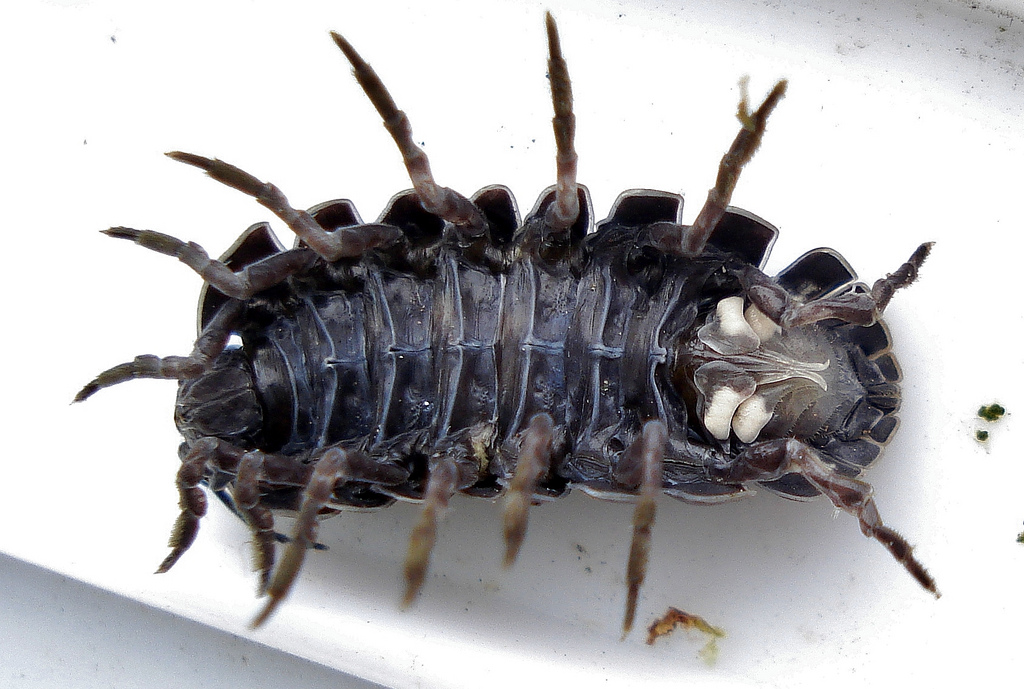Reproduction
The Armadillidium vulgare reproduce sexually during the spring and summer months. They reproduce through sexual reproduction (they cannot reproduce through parthenogenesis which is reproduction without fertilization) so they require sperm to fertilize their eggs (Raham 1986). Their reproduction is triggered according to sunlight; during longer days the species begins and undergoes breeding, while during shorter days they stop sexual activities (Souty-Grosset, et al. 1998). The breeding period lasts for about six months (Paris and Pitelka 1962). Females begin to reproduce at around two to three years old. Females produce one brood during their first year of reproduction, and two broods each year after that. The number of eggs that a female lays is dependent on her age and size; the larger and older the female, the more eggs she will lay (Raham 1986). During the process of reproduction the males mount the backs of the females in order to inject their sperm into the female genetalia (The Natural Source 1997).
 The A. vulgare are marsupials like
the
Red Kangaroo and the
Koala so after
fertilization the eggs are moved in to an abdominal pouch on the
mother and remain in these pouches for 32 days. The pouches
are so filled with eggs that the mothers’ feeding abilities are
heavily reduced. After about the 25th day in the pouch, the eggs
hatch and the bodies of the young isopods are soft. The A.
vulgare have a direct life cycle because they do not undergo a
completely morphological change. In other words, they are born
looking like miniature versions of the adult form. When the
young finally emerge from the pouch on the 32nd day, their
exoskeletons have hardened significantly from minerals provided by
the mother (Lawlor 1976). It
takes about a year for the A. vulgare undergo the necessary
molts in which they gain their seventh pair of legs and to be
considered an adult (The Natural Source 1997). Once the young
A. vulgare emerge from the brood pouch, they are left to
fend for themselves (the parents are not actively involved in
raising them). The broods can be a mix of males and females or
they can be completely female or completely male (Raham 1986).
The A. vulgare are marsupials like
the
Red Kangaroo and the
Koala so after
fertilization the eggs are moved in to an abdominal pouch on the
mother and remain in these pouches for 32 days. The pouches
are so filled with eggs that the mothers’ feeding abilities are
heavily reduced. After about the 25th day in the pouch, the eggs
hatch and the bodies of the young isopods are soft. The A.
vulgare have a direct life cycle because they do not undergo a
completely morphological change. In other words, they are born
looking like miniature versions of the adult form. When the
young finally emerge from the pouch on the 32nd day, their
exoskeletons have hardened significantly from minerals provided by
the mother (Lawlor 1976). It
takes about a year for the A. vulgare undergo the necessary
molts in which they gain their seventh pair of legs and to be
considered an adult (The Natural Source 1997). Once the young
A. vulgare emerge from the brood pouch, they are left to
fend for themselves (the parents are not actively involved in
raising them). The broods can be a mix of males and females or
they can be completely female or completely male (Raham 1986).
When finding mates, the A. vulgare depend on chemicals, visual and auditory cues and touch. Chemicals such as sex pheromones are used not only to find a mate but also to evaluate that individual as a mate. The attractiveness of the females is assessed by their point in their molting cycle (Beauché and Richard 2013). During the reproductive cycle, the females undergo a molt which changes the structure of their genetalia and creates the marsupium important to the reproductive process mentioned above (Suzuki and Ziegler 2011). Males are more attracted to females during the beginning stages of their molt than the middle or end (Beauché and Richard 2013).
Return to Home Discover more on our Interactions page
